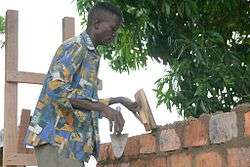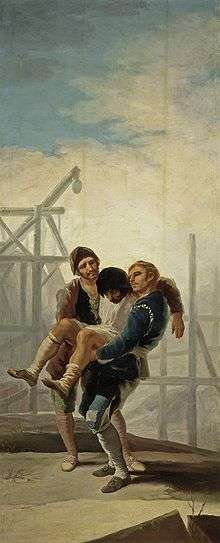Bricklayer
A bricklayer, which is related to but different from a mason, is a craftsman and tradesman who lays bricks to construct brickwork. The terms also refer to personnel who use blocks to construct blockwork walls and other forms of masonry.[1] In British and Australian English, a bricklayer is colloquially known as a "brickie".[2] A stone mason is one who lays any combination of stones, cinder blocks, and bricks in construction of building walls and other works. The main difference between a bricklayer and a true mason is skill level: bricklaying is a part of masonry and considered to be a "lower" form of masonry, whereas stonemasonry is a specialist occupation involved in the cutting and shaping of stones and stonework.[3]
| Occupation | |
|---|---|
Occupation type | Craftsman |
Activity sectors | Construction |
| Description | |
Education required | Apprenticeship |

Bricklaying may also be enjoyed as a hobby. For example, the former British Prime Minister Winston Churchill did bricklaying as a hobby.
Bricklayers occasionally enter competitions where both speed and accuracy are judged. The largest is the "Spec-Mix Bricklayer 500" held annually in Las Vegas, Nevada, USA.
Required training
Bricklaying and masonry are ancient professions that even centuries later require modern training. Bricklayers usually go through a formal apprenticeship which includes about three to four years of on-the-job training combined with classroom instruction. Unions and many employers offer these apprenticeships. To become an apprentice, one must be at least 18 years old and have graduated from high school. Masons must attend trade school and/or serve apprenticeships requiring that they demonstrate that they know how to protect homes from humidity or water ingress, know about thermal insulation, and know about the science of construction material and occupational health and safety. While some online sites say they can get you certified in a little as 30 days, most bricklayers today attend trade or technical schools and receive in-depth and thorough training.
Guild clothing of the German bricklayers
- Picture of an Ehrbarkeit
- Traditional belt-buckle of a bricklayer (it reads: Extol the bricklayer's art).
- The buckle is worn on a belt very much like this (this is a belt of a roofer)
- Bricklayer trousers
 A bricklayer in Paoua, Central African Republic
A bricklayer in Paoua, Central African Republic - Traditional bricklayer waistcoat (most times this is not white, but rather grey)
In fiction

- Italian-American author John Fante featured hod carriers, bricklayers, and stonemasons prominently in several novels and short stories. This was due to the autobiographical nature of much of Fante's writing; his father, Nick, was an Italian-born bricklayer descended from — at least in Fante's fictions — a long line of Italian artisan bricklayers and stonemasons. Fante also spent a significant portion of his youth apprenticed to his father.
- In Aleksandr Solzhenitsyn's One Day in the Life of Ivan Denisovich, the title character, a Gulag prisoner, worked as a bricklayer.
- The long-running British children's TV series Look and Read featured "Bill the Brickie" ("brickie" being a British and Australian colloquialism for "bricklayer"), who would 'build' words with bricks to demonstrate the use of morphemes, such as '-ed' or '-ing'.
See also
References
- Richard T. Kreh (2003). Masonry Skills. Thomson Delmar Learning. ISBN 0-7668-5936-3.
- "bricklayer noun - Definition, pictures, pronunciation and usage notes | Oxford Advanced Learner's Dictionary at OxfordLearnersDictionaries.com". Oald8.oxfordlearnersdictionaries.com. Retrieved 2017-04-02.
- Paolo Berizzi (September 20, 2006). "Muratori, cottimo e stress la cocaina invade i cantieri". repubblica.it (in Italian).

| Wikimedia Commons has media related to Masons. |